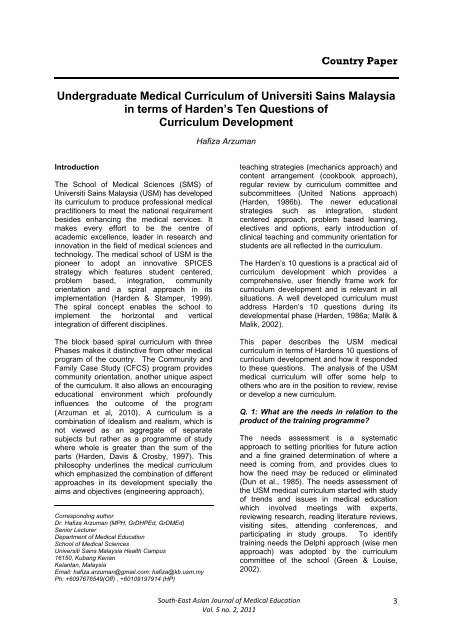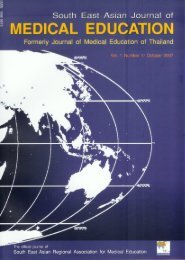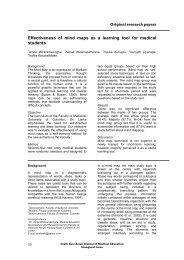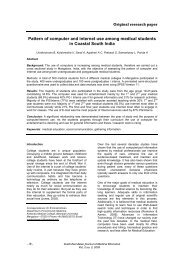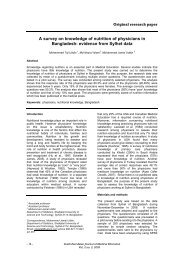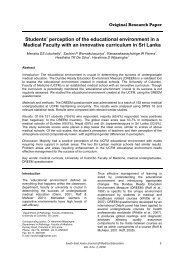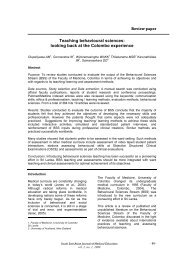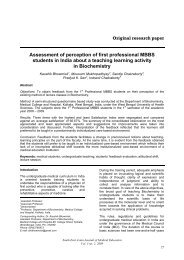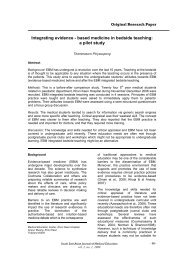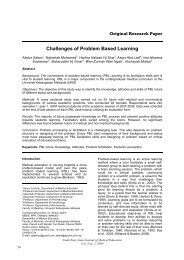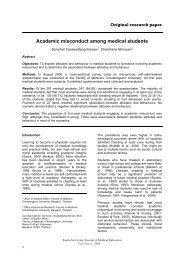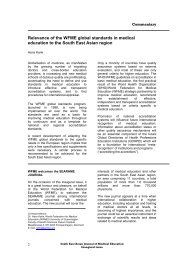Undergraduate Medical Curriculum of Universiti Sains Malaysia in ...
Undergraduate Medical Curriculum of Universiti Sains Malaysia in ...
Undergraduate Medical Curriculum of Universiti Sains Malaysia in ...
You also want an ePaper? Increase the reach of your titles
YUMPU automatically turns print PDFs into web optimized ePapers that Google loves.
Country Paper<br />
<strong>Undergraduate</strong> <strong>Medical</strong> <strong>Curriculum</strong> <strong>of</strong> <strong>Universiti</strong> <strong>Sa<strong>in</strong>s</strong> <strong>Malaysia</strong><br />
<strong>in</strong> terms <strong>of</strong> Harden’s Ten Questions <strong>of</strong><br />
<strong>Curriculum</strong> Development<br />
Hafiza Arzuman<br />
Introduction<br />
The School <strong>of</strong> <strong>Medical</strong> Sciences (SMS) <strong>of</strong><br />
<strong>Universiti</strong> <strong>Sa<strong>in</strong>s</strong> <strong>Malaysia</strong> (USM) has developed<br />
its curriculum to produce pr<strong>of</strong>essional medical<br />
practitioners to meet the national requirement<br />
besides enhanc<strong>in</strong>g the medical services. It<br />
makes every effort to be the centre <strong>of</strong><br />
academic excellence, leader <strong>in</strong> research and<br />
<strong>in</strong>novation <strong>in</strong> the field <strong>of</strong> medical sciences and<br />
technology. The medical school <strong>of</strong> USM is the<br />
pioneer to adopt an <strong>in</strong>novative SPICES<br />
strategy which features student centered,<br />
problem based, <strong>in</strong>tegration, community<br />
orientation and a spiral approach <strong>in</strong> its<br />
implementation (Harden & Stamper, 1999).<br />
The spiral concept enables the school to<br />
implement the horizontal and vertical<br />
<strong>in</strong>tegration <strong>of</strong> different discipl<strong>in</strong>es.<br />
The block based spiral curriculum with three<br />
Phases makes it dist<strong>in</strong>ctive from other medical<br />
program <strong>of</strong> the country. The Community and<br />
Family Case Study (CFCS) program provides<br />
community orientation, another unique aspect<br />
<strong>of</strong> the curriculum. It also allows an encourag<strong>in</strong>g<br />
educational environment which pr<strong>of</strong>oundly<br />
<strong>in</strong>fluences the outcome <strong>of</strong> the program<br />
(Arzuman et al, 2010). A curriculum is a<br />
comb<strong>in</strong>ation <strong>of</strong> idealism and realism, which is<br />
not viewed as an aggregate <strong>of</strong> separate<br />
subjects but rather as a programme <strong>of</strong> study<br />
where whole is greater than the sum <strong>of</strong> the<br />
parts (Harden, Davis & Crosby, 1997). This<br />
philosophy underl<strong>in</strong>es the medical curriculum<br />
which emphasized the comb<strong>in</strong>ation <strong>of</strong> different<br />
approaches <strong>in</strong> its development specially the<br />
aims and objectives (eng<strong>in</strong>eer<strong>in</strong>g approach),<br />
Correspond<strong>in</strong>g author<br />
Dr. Hafiza Arzuman (MPH, GrDHPEd, GrDMEd)<br />
Senior Lecturer<br />
Department <strong>of</strong> <strong>Medical</strong> Education<br />
School <strong>of</strong> <strong>Medical</strong> Sciences<br />
<strong>Universiti</strong> <strong>Sa<strong>in</strong>s</strong> <strong>Malaysia</strong> Health Campus<br />
16150, Kubang Kerian<br />
Kelantan, <strong>Malaysia</strong><br />
Email: hafiza.arzuman@gmail.com; hafiza@kb.usm.my<br />
Ph: +6097676549(Off) , +60109197914 (HP)<br />
teach<strong>in</strong>g strategies (mechanics approach) and<br />
content arrangement (cookbook approach),<br />
regular review by curriculum committee and<br />
subcommittees (United Nations approach)<br />
(Harden, 1986b). The newer educational<br />
strategies such as <strong>in</strong>tegration, student<br />
centered approach, problem based learn<strong>in</strong>g,<br />
electives and options, early <strong>in</strong>troduction <strong>of</strong><br />
cl<strong>in</strong>ical teach<strong>in</strong>g and community orientation for<br />
students are all reflected <strong>in</strong> the curriculum.<br />
The Harden’s 10 questions is a practical aid <strong>of</strong><br />
curriculum development which provides a<br />
comprehensive, user friendly frame work for<br />
curriculum development and is relevant <strong>in</strong> all<br />
situations. A well developed curriculum must<br />
address Harden’s 10 questions dur<strong>in</strong>g its<br />
developmental phase (Harden, 1986a; Malik &<br />
Malik, 2002).<br />
This paper describes the USM medical<br />
curriculum <strong>in</strong> terms <strong>of</strong> Hardens 10 questions <strong>of</strong><br />
curriculum development and how it responded<br />
to these questions. The analysis <strong>of</strong> the USM<br />
medical curriculum will <strong>of</strong>fer some help to<br />
others who are <strong>in</strong> the position to review, revise<br />
or develop a new curriculum.<br />
Q. 1: What are the needs <strong>in</strong> relation to the<br />
product <strong>of</strong> the tra<strong>in</strong><strong>in</strong>g programme<br />
The needs assessment is a systematic<br />
approach to sett<strong>in</strong>g priorities for future action<br />
and a f<strong>in</strong>e gra<strong>in</strong>ed determ<strong>in</strong>ation <strong>of</strong> where a<br />
need is com<strong>in</strong>g from, and provides clues to<br />
how the need may be reduced or elim<strong>in</strong>ated<br />
(Dun et al., 1985). The needs assessment <strong>of</strong><br />
the USM medical curriculum started with study<br />
<strong>of</strong> trends and issues <strong>in</strong> medical education<br />
which <strong>in</strong>volved meet<strong>in</strong>gs with experts,<br />
review<strong>in</strong>g research, read<strong>in</strong>g literature reviews,<br />
visit<strong>in</strong>g sites, attend<strong>in</strong>g conferences, and<br />
participat<strong>in</strong>g <strong>in</strong> study groups. To identify<br />
tra<strong>in</strong><strong>in</strong>g needs the Delphi approach (wise men<br />
approach) was adopted by the curriculum<br />
committee <strong>of</strong> the school (Green & Louise,<br />
2002).<br />
South‐East Asian Journal <strong>of</strong> <strong>Medical</strong> Education<br />
Vol. 5 no. 2, 2011<br />
3
Q 2: What are the aims and objectives<br />
Hav<strong>in</strong>g identified the tra<strong>in</strong><strong>in</strong>g needs, the<br />
curriculum addressed the aims and objectives<br />
<strong>of</strong> the curriculum. It highlighted the fact that a<br />
patient is a human <strong>in</strong> the family and<br />
community perspectively. In general, the aim<br />
<strong>of</strong> the curriculum is to ‘highlight’ a wider scale<br />
<strong>of</strong> awareness <strong>of</strong> medical graduates about their<br />
responsibility <strong>in</strong> a society. Besides, it<br />
emphasized on possess<strong>in</strong>g a leadership<br />
criteria while also be<strong>in</strong>g capable <strong>of</strong> cont<strong>in</strong>u<strong>in</strong>g<br />
their education. The curriculum emphasized<br />
on education for capability and has created a<br />
concept <strong>of</strong> an efficient medical practitioner <strong>in</strong><br />
which a doctor upon receiv<strong>in</strong>g his/her degree is<br />
equipped with medical knowledge and skill to<br />
resolve <strong>in</strong>dividuals and community problems.<br />
(http://www.medic.usm.my/undergraduate/)<br />
Q 3: What content is <strong>in</strong>cluded<br />
The USM medical course is an <strong>in</strong>tegrated<br />
program with a five-year duration and divided<br />
<strong>in</strong>to three Phases. Each Phase has different<br />
blocks/systems with its learn<strong>in</strong>g objectives and<br />
content <strong>in</strong>cluded <strong>in</strong> each Phase based on the<br />
learn<strong>in</strong>g objectives <strong>of</strong> the block/system.<br />
Figure 1: Different Phases <strong>of</strong> MD curriculum with content outl<strong>in</strong>e<br />
Phase I: year 1<br />
Basic medical sciences <strong>in</strong> blocks<br />
Phase II: years 2 and 3<br />
Abnormal structure, pathogenesis and pathophysiology <strong>in</strong> blocks<br />
Phase III: years 4 and 5<br />
Cl<strong>in</strong>ical application <strong>of</strong> the Phase I & II learn<strong>in</strong>g <strong>in</strong> blocks and rotational post<strong>in</strong>gs<br />
In Phase I the identified content is the normal<br />
structures, functions and normal body<br />
mechanisms. The courses <strong>of</strong> behavioral<br />
sciences nurs<strong>in</strong>g, first aid, bio-ethics and<br />
communication skills are <strong>in</strong>troduced as a<br />
preparation for CFCS <strong>in</strong> Phase II.<br />
In Phase II the content is identified to correlate<br />
the students’ basic knowledge acquired <strong>in</strong><br />
Phase I to the advance knowledge <strong>of</strong><br />
pathogenesis and pathophysiology, cl<strong>in</strong>ical<br />
and systemic disease <strong>of</strong> Phase II. The CFCS<br />
program is <strong>in</strong>troduced as a block <strong>in</strong> year 2 for<br />
community orientation <strong>of</strong> the students.<br />
In Phase III the content is identified for the<br />
application <strong>of</strong> the acquired Phase I and II<br />
knowledge to solve patient’s problem <strong>in</strong> the<br />
<strong>in</strong>dividual and <strong>in</strong> the perspectives <strong>of</strong> the<br />
community. This Phase has been divided <strong>in</strong>to:<br />
• Interdiscipl<strong>in</strong>ary activities (general blocks)<br />
• Rotational post<strong>in</strong>gs (specific blocks) and<br />
• Self study<br />
4 South‐East Asian Journal <strong>of</strong> <strong>Medical</strong> Education<br />
Vol. 5 no. 2, 2011
Figure 2: Spiral organization <strong>of</strong> the content <strong>of</strong> medical curriculum (Harden R.M, & Stamper N, 1999)<br />
Houseman Ship<br />
Q 4: How is the content organized<br />
The unique feature <strong>of</strong> the curriculum is the<br />
system based spiral arrangement <strong>of</strong> its content<br />
(Figure 2). A spiral curriculum has an iterative<br />
revisit<strong>in</strong>g <strong>of</strong> topics, subjects or themes<br />
throughout the course with deepen<strong>in</strong>g <strong>of</strong> the<br />
content, with each successive encounter<br />
build<strong>in</strong>g on the previous one (Harden &<br />
Stamper, 1999). All the three Phases <strong>of</strong> the<br />
curriculum are comb<strong>in</strong>ed <strong>in</strong> a spiral concept<br />
with a close relationship between one Phase<br />
to the other. Learn<strong>in</strong>g activities <strong>in</strong> Phase I<br />
forms the first level <strong>of</strong> the spiral, it is explored<br />
<strong>in</strong> depth <strong>in</strong> Phase II and Phase III. In the<br />
curriculum students move on through different<br />
experiences and there is a chance <strong>of</strong> revisit<strong>in</strong>g<br />
previous learn<strong>in</strong>g to re-explore and<br />
extent it, which is based on the constructivist<br />
learn<strong>in</strong>g approach. The content is <strong>in</strong>tegrated<br />
both horizontally and vertically while the spiral<br />
approach l<strong>in</strong>ked the theory to practice,<br />
<strong>in</strong>creas<strong>in</strong>g the time for cl<strong>in</strong>ical activities and<br />
allow<strong>in</strong>g students to spend more time with<br />
patients, so they can apply their theoretical<br />
knowledge <strong>in</strong>to cl<strong>in</strong>ical practice.<br />
Q 5: What educational strategies are<br />
adopted<br />
The school adopted a mix approach with<br />
emphasis on the SPICES strategy <strong>in</strong> its<br />
curriculum implementation. In Phase I there is<br />
a horizontal <strong>in</strong>tegration among the basic<br />
subjects with some amount <strong>of</strong> vertical<br />
<strong>in</strong>tegration <strong>in</strong> nurs<strong>in</strong>g and first aid block. In this<br />
Phase the <strong>in</strong>tegration is at the level <strong>of</strong><br />
harmonization and nest<strong>in</strong>g <strong>of</strong> the <strong>in</strong>tegration<br />
ladder. Phase II onwards the <strong>in</strong>tegration moves<br />
to a higher level like temporal coord<strong>in</strong>ation,<br />
shar<strong>in</strong>g, correlation and multidiscipl<strong>in</strong>ary<br />
especially, whereas <strong>in</strong> Phase III the <strong>in</strong>tegration<br />
to achieve the highest trans-discipl<strong>in</strong>ary and<br />
<strong>in</strong>ter/multidiscipl<strong>in</strong>ary level. (Harden, 2000).<br />
The community orientation started <strong>in</strong> Phase II<br />
through the CFCS block which cont<strong>in</strong>ued until<br />
year 5 as Family Medic<strong>in</strong>e and Community<br />
Medic<strong>in</strong>e Block. A number <strong>of</strong> areas for<br />
electives are <strong>of</strong>fered by the elective<br />
committee. Students are also allowed to<br />
choose their own area <strong>of</strong> <strong>in</strong>terest for elective<br />
study <strong>in</strong> year 4 elective post<strong>in</strong>g.<br />
The systemic approach is practiced <strong>in</strong> cl<strong>in</strong>ical<br />
teach<strong>in</strong>g where each student rotates based on<br />
their post<strong>in</strong>gs. In hospital they rotate <strong>in</strong><br />
outpatient and <strong>in</strong>patient, from general to<br />
specific health problems. They also rotate to<br />
other health care sectors, community cl<strong>in</strong>ics<br />
and so on and are monitored by log book or<br />
360 0 assessment. Though the curriculum is an<br />
<strong>in</strong>tegrated, problem-based and systemic, there<br />
are still some amount <strong>of</strong> teacher centered<br />
approach is practiced especially <strong>in</strong> year 1.<br />
This is because these students have<br />
<strong>in</strong>sufficient knowledge about their role <strong>in</strong><br />
student centre learn<strong>in</strong>g.<br />
South‐East Asian Journal <strong>of</strong> <strong>Medical</strong> Education<br />
Vol. 5 no. 2, 2011<br />
5
Q 6: What teach<strong>in</strong>g methods are used<br />
Lecture, demonstration, practical, fixed learn<strong>in</strong>g<br />
module, tutorial and early cl<strong>in</strong>ical contact <strong>in</strong><br />
first aid and nurs<strong>in</strong>g blocks are the ma<strong>in</strong><br />
educational methods with horizontal <strong>in</strong>tegration<br />
<strong>in</strong> Phase I. The lecture is used to <strong>in</strong>troduce the<br />
newer and difficult concept to the students<br />
which tutorial sessions. Tutorial encourages<br />
students to be more active learners and make<br />
them more responsible to learn by themselves<br />
with some help from their tutors. Practicum<br />
and demonstration are ma<strong>in</strong>ly used for learn<strong>in</strong>g<br />
basic and applied anatomy, physiology,<br />
chemical pathology and basic cl<strong>in</strong>ical<br />
procedures like nurs<strong>in</strong>g care, communication<br />
skills, and first aid management. In Phase II the<br />
ma<strong>in</strong> teach<strong>in</strong>g methods are problem based<br />
learn<strong>in</strong>g (PBL), fixed learn<strong>in</strong>g module, the<br />
cl<strong>in</strong>ical skills centre teach<strong>in</strong>g (CSC), expose to<br />
real patient <strong>in</strong> the hospital and a community<br />
orientated program with some amount <strong>of</strong><br />
lecture. Students are oriented about the<br />
process <strong>of</strong> PBL before they proceed for it. The<br />
educational methods <strong>in</strong> Phase III are reflected<br />
by:<br />
a) <strong>in</strong>tegrated multidiscipl<strong>in</strong>ary teach<strong>in</strong>g;<br />
b) modified subject/discipl<strong>in</strong>e based;<br />
c) problem based and problem solv<strong>in</strong>g;<br />
and<br />
d) community oriented/based and self-study<br />
In the self-study period students are expected<br />
to be <strong>in</strong> the library, CSC, ward, accident and<br />
emergency cl<strong>in</strong>ics or operation theater to know<br />
the patient socially and cl<strong>in</strong>ically, practice<br />
relevant cl<strong>in</strong>ical skills, and to discuss with<br />
peers, lecturers or any other relevant persons.<br />
Q 7: How the assessment is carried out<br />
In each Phase a range <strong>of</strong> assessment<br />
methods have been adopted to assess the<br />
learn<strong>in</strong>g outcomes <strong>of</strong> the curriculum correctly<br />
and reliably. The assessment is carefully<br />
planned and designed so that it is reflective <strong>of</strong><br />
the curriculum aims and objectives. There is a<br />
comb<strong>in</strong>ation <strong>of</strong> cont<strong>in</strong>uous and summative<br />
assessments. The Phase I has Slide Spot<br />
Assessment (SSA) <strong>in</strong> cont<strong>in</strong>uous assessment<br />
to prepare students for actual Objective<br />
Structure Practical Exam<strong>in</strong>ation (OSPE)/<br />
Objective Structure Cl<strong>in</strong>ical Exam<strong>in</strong>ation<br />
(OSCE) for summative assessment with<br />
Multiple Choice Questions (MCQs) and Short<br />
Essay Questions (SAQ). To assess students’<br />
cognitive knowledge <strong>in</strong> a wider scale the<br />
Phase II uses Structured Essay Questions<br />
(SEQ) and MCQs. The SEQ questions are<br />
structured to make it objective and constructed<br />
based on case scenario which assesses<br />
students’ critical and higher order th<strong>in</strong>k<strong>in</strong>g<br />
ability, problem solv<strong>in</strong>g skills, application <strong>of</strong><br />
knowledge and decision mak<strong>in</strong>g skills.<br />
OSPE/OSCE are used to assess students’<br />
psychomotor and communication skills. In<br />
Phase III the cont<strong>in</strong>uous assessment <strong>of</strong> each<br />
block post<strong>in</strong>g consists <strong>of</strong> a) attendance <strong>in</strong><br />
different educational activities, b) satisfactory<br />
completion <strong>of</strong> log book, c) satisfactory case<br />
write-ups and end <strong>of</strong> block assessment. The<br />
end <strong>of</strong> block assessment is carried out by<br />
MCQs, Modified Essay Questions (MEQ),<br />
short and long cases, OSCE and oral test. As<br />
the course precedes, the assessment format<br />
changes from simple SAQs to SEQs to MEQs<br />
and so on to test the learn<strong>in</strong>g objectives<br />
accurately as per the learn<strong>in</strong>g experiences <strong>of</strong><br />
the students.<br />
Q 8: How details <strong>of</strong> the curriculum are<br />
communicated<br />
The details <strong>of</strong> USM medical curriculum is<br />
communicated <strong>in</strong> many ways to all<br />
stakeholders. The prospectus book <strong>in</strong>cludes<br />
the details <strong>of</strong> the course objectives, content<br />
and facts, entry prerequisites, resource<br />
available and other necessary <strong>in</strong>formation for<br />
the potential candidates. Each Phase<br />
chairperson is responsible to communicate<br />
any changes <strong>in</strong> the curriculum, timetables and<br />
other <strong>in</strong>formation to the teachers, students and<br />
the academic support staff. The curriculum<br />
book <strong>of</strong> each Phase has the relevant<br />
<strong>in</strong>formation for teachers and students. At the<br />
beg<strong>in</strong>n<strong>in</strong>g <strong>of</strong> each Phase students are oriented<br />
thoroughly about the format <strong>of</strong> the Phase,<br />
teach<strong>in</strong>g methods, assessment techniques,<br />
resource available and other <strong>in</strong>formation by<br />
the respective chairperson and by the Deputy<br />
Dean, Academic and Students Development.<br />
The ma<strong>in</strong> stakeholder, the M<strong>in</strong>istry <strong>of</strong> Health is<br />
fully <strong>in</strong>formed about the curriculum and its<br />
implementation status and any changes by the<br />
concerned people.<br />
Question 9: What educational environment<br />
is fostered<br />
The prevail<strong>in</strong>g conducive educational<br />
environment <strong>of</strong> the medical school is favorable<br />
for its operation and pr<strong>of</strong>oundly <strong>in</strong>fluenc<strong>in</strong>g the<br />
outcome <strong>of</strong> the programme. It has all the<br />
support facilities for teach<strong>in</strong>g and students<br />
support. The students also identified the<br />
overall educational environment <strong>of</strong> the USM<br />
medical school is comfortable for them and<br />
their social life is higher than average<br />
(Arzuman et al, 2010).<br />
6 South‐East Asian Journal <strong>of</strong> <strong>Medical</strong> Education<br />
Vol. 5 no. 2, 2011
Figure 3: Educational management process <strong>of</strong> the medical programme, USM<br />
Dean, School <strong>of</strong> <strong>Medical</strong> Sciences, USM<br />
Deputy Dean Academic and Student Development<br />
<strong>Curriculum</strong> Committee<br />
Phase I Chairperson Phase II Chairperson Phase III Chairperson<br />
• Coord<strong>in</strong>ators <strong>of</strong><br />
different blocks<br />
• Block members<br />
• CFCS coord<strong>in</strong>ator<br />
• Exam committee<br />
• Support staff and<br />
service from academic<br />
<strong>of</strong>fice<br />
• Coord<strong>in</strong>ators <strong>of</strong><br />
different blocks<br />
• CSC coord<strong>in</strong>ator<br />
• CFCS coord<strong>in</strong>ator<br />
• Block members<br />
• Exam committee<br />
• Support staff and<br />
service from academic<br />
<strong>of</strong>fice<br />
• Coord<strong>in</strong>ators <strong>of</strong> the<br />
blocks<br />
• Coord<strong>in</strong>ators <strong>of</strong> cl<strong>in</strong>ical<br />
post<strong>in</strong>gs<br />
• CSC coord<strong>in</strong>ator<br />
• Exam committee<br />
• CFCS coord<strong>in</strong>ator<br />
• Block members<br />
• Exam committee<br />
• Support staff and<br />
service from academic<br />
Q 10: How the process is managed<br />
The whole educational process is managed by<br />
the Dean <strong>of</strong> the <strong>Medical</strong> School, Deputy Dean<br />
<strong>of</strong> Academic and Student Development and<br />
the academic <strong>of</strong>fice <strong>of</strong> the school. The<br />
management process is shown by the figure 3<br />
Conclusion<br />
The USM medical course is a multi-discipl<strong>in</strong>e<br />
educational system which successfully<br />
addressed Harden’s 10 questions and thereby<br />
fulfilled the criteria <strong>of</strong> a well developed<br />
curriculum. The significant features <strong>of</strong> the<br />
curriculum are <strong>in</strong>tegration <strong>of</strong> teach<strong>in</strong>g and<br />
organ-base education system focus<strong>in</strong>g on<br />
SPICES strategy. The <strong>Medical</strong> School is<br />
committed to enhance the competitive nature<br />
<strong>of</strong> its students and promot<strong>in</strong>g their <strong>in</strong>tellectual<br />
and educational quests, provid<strong>in</strong>g confidence<br />
for cont<strong>in</strong>u<strong>in</strong>g study and a sense <strong>of</strong> social<br />
accountability.<br />
Conflicts <strong>of</strong> <strong>in</strong>terest<br />
The author reports no conflict <strong>of</strong> <strong>in</strong>terest. The<br />
author alone is responsible for the content and<br />
writ<strong>in</strong>g <strong>of</strong> the paper.<br />
References<br />
Arzuman, H., Yus<strong>of</strong>f, M.S.B. & Chit, S.P. (2010) Big<br />
Sib Students’ perceptions <strong>of</strong> the educational<br />
environment at the School <strong>of</strong> <strong>Medical</strong> Sciences,<br />
<strong>Universiti</strong> <strong>Sa<strong>in</strong>s</strong> <strong>Malaysia</strong>, us<strong>in</strong>g Dundee Ready<br />
Educational Environment Measure (DREEM)<br />
Inventory, <strong>Malaysia</strong>n Journal <strong>of</strong> <strong>Medical</strong><br />
Sciences, 17, 3, pp. 40-47.<br />
Dunn, W.R., Hamilton, D.D. & Harden, R.M. (1985)<br />
Techniques <strong>of</strong> identify<strong>in</strong>g competencies<br />
needed <strong>of</strong> doctors, <strong>Medical</strong> Teacher, 7, 1, pp.<br />
15-25.<br />
Green, D. & Louise D. (2002). How should we best<br />
tra<strong>in</strong> cl<strong>in</strong>ical psychology supervisors A Delphi<br />
survey, Psychology Learn<strong>in</strong>g and Teach<strong>in</strong>g, 2,<br />
2, pp.106-115.<br />
South‐East Asian Journal <strong>of</strong> <strong>Medical</strong> Education<br />
Vol. 5 no. 2, 2011<br />
7
Harden, R.M. (1986a) Ten questions to ask when<br />
plann<strong>in</strong>g a course or curriculum, <strong>Medical</strong><br />
Education, 20, 4, pp. 356-65.<br />
Harden, R.M. (1986b) Approaches to curriculum<br />
plann<strong>in</strong>g, <strong>Medical</strong> Education, 21, pp. 458-466.<br />
Harden, R.M. (2000) The <strong>in</strong>tegration ladder - A tool<br />
for curriculum plann<strong>in</strong>g and evaluation, <strong>Medical</strong><br />
Education, 34, pp. 551-557.<br />
Harden, R.M., Davis M. H. & Crosby J.R. (1997)<br />
The new Dundee medical curriculum: a whole<br />
that is greater than the sum <strong>of</strong> the parts.<br />
<strong>Medical</strong> Education, 31(4), pp. 264-71.<br />
Harden, R.M., & Stamper, N. (1999) What is spiral<br />
curriculum <strong>Medical</strong> Teacher, 21, 2, pp.141-<br />
143.<br />
Malik, A. S. & Malik, R. H. (2002) The undergraduate<br />
curriculum <strong>of</strong> Faculty <strong>of</strong> Medic<strong>in</strong>e and Health<br />
Sciences, <strong>Universiti</strong> <strong>Malaysia</strong> Sarawak <strong>in</strong> terms<br />
<strong>of</strong> Harden's 10 questions, <strong>Medical</strong> Teacher, 24,<br />
6, pp. 616-621.<br />
School <strong>of</strong> <strong>Medical</strong> Sciences, <strong>Undergraduate</strong> curriculum<br />
aims, [onl<strong>in</strong>e], available at: http://www.medic.<br />
usm.my/undergraduate/ (accessed on April 27,<br />
2010).<br />
8 South‐East Asian Journal <strong>of</strong> <strong>Medical</strong> Education<br />
Vol. 5 no. 2, 2011


